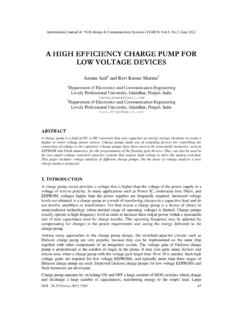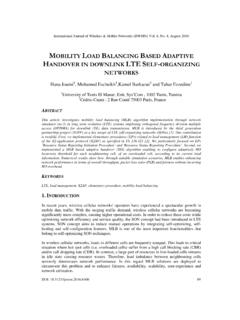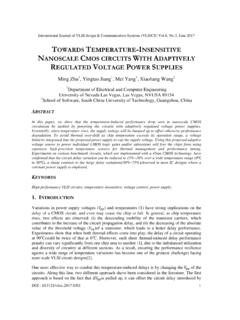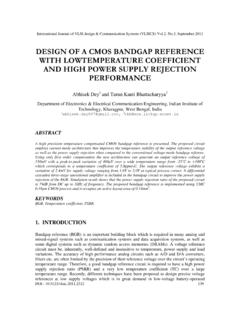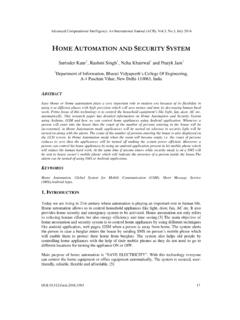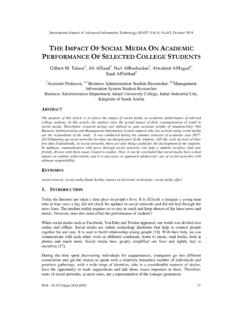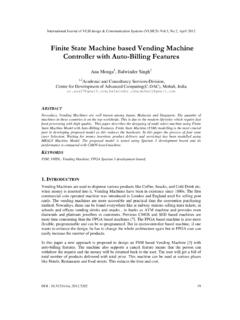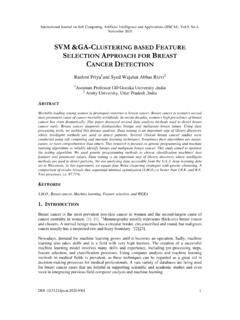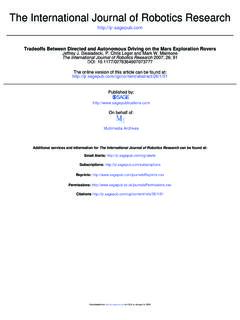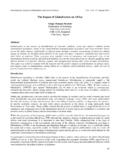Transcription of International Journal on Integrating Technology in ...
1 International Journal on Integrating Technology in Education (IJITE) , , March 2018 DOI 13 DESIGN OF AN ANATOMICAL SIMULATOR FOR MEDICAL TRAINING. A 3D PRINTING PROJECT OF INDUSTRIAL DESIGNERS AND MEDICAL STUDENTS. Juan Sebasti n Avila Forero1, Manuel Mart nez Tor n2 and Marco De Rossi Estrada2 1 Creation and Communication Faculty, Universidad El Bosque, Colombia. 2 Drawing Departament, FabLab Valencia, Universitat Polit cnica de Val ncia, Spain. 3 Design, manufacturing and management of industrial projects, PhD student at the Universitat Polit cnica de Val ncia, Spain.
2 ABSTRACT The Phantoscar project is a human body simulator recreated in a three-dimensional physical platform, with realistic position of organs and systems, obtained by means of 3D printing, to perform simulations by catheterization or laparoscopy in its specific spatial location within the human body and thus to realize different types of customized surgical simulations. It is the result of coordinated work between designers, engineers and health specialists, based on the use of additive manufacturing technologies, medical image segmentation and polygonal mesh editing (MESH), development of molds and reproductions with synthetic materials and similar properties to the tissues of the human body.
3 KEYWORDS Anatomy, 3D printing, Digital, Sculpture, Education, Simulation. 1. INTRODUCTION 3D printing technologies have become an important tool for manufacturing on 21st century, finding new applications in different areas of research, being the medical field one of the most striking in terms of application, with a wide diffusion in terms of scientific communication and mass media, which has opened a space for an economic exploitation in the market. [1.] This article presents the workflow for the design and manufacture of organs and/or customized simulators using different technologies commonly used by design professionals and three-dimensional modelling, in order to illustrate how the training phantom would work with different Configurations, demonstrating the efficiency of the applied techniques, the advantages and the potential of the phantom so that it can become a helpful program.
4 For several years, thanks to advances in medical imaging, the way doctors and surgeons can visualize and plan interventions has evolved, initially from two-dimensional resources like x-rays, then three-dimensional manipulating a virtual 3D model on a computer and currently materializing in three dimensions parts of the human body through 3D printing. This advancement in terms of surgery planning and human body understanding, has allowed to customize three-dimensional physical surgical guides, personalized organs of real patients for study and training simulators and surgical planning.
5 [2.] "You only have one opportunity to carve a graft obtained from a patient's rib, so you have to do it perfectly the first time, it takes years of practice to learn the technical skills to do it. This was a International Journal on Integrating Technology in Education (IJITE) , , March 2018 14 very realistic experience and what is great is that you can continue printing dozens of these models at the same time so you can practice again and again , says Dr Cher Zhao, University of Michigan Medical School resident. [3.] Starting from the boom and advances in 3D printing it is now possible to customize, materialize and three-dimensionalize organs and internal systems to visualize and physically feel anatomical structures of patients before performing any intervention.
6 [4.] Figure 1. Simula Project. Organs made from 3D printing of models and molds, reproductions with silicones. Degree work. Student: Leonel Hern ndez. Director: Prof: Juan Avila El Bosque University. 2016 Using materials and effects that simulate the context that can be found in a real patient and thus to prepare a better surgical intervention, contributing to patient and specialist safety, increasing the chances of success in an intervention. [5.] On a relevant field, 3D manufacturing and printing methods have been evolving rapidly in the last 10 years, making the Technology more accessible and with more applications in institutions and with the general public thanks to the Maker Movement [6.]
7 ] [7.], nevertheless it is a field that continues developing and that is in a crucial point so that, large projects can be built with few resources to have endless possibilities of exploration. [8.] This project plans to showcase a successful application of these technologies, as well as their viability and relevance in the field of medical training. The research carried out is the result of a coordinated work between the Universidad El Bosque de Bogot , the Hospital La Fe de Valencia and the Universidad Polit cnica de Valencia to manufacture a simulator for medical training to improve the skills of surgeons in the practice of a surgical intervention through catheterization technique and subsequently modified to increase its spectrum use with surgical laparoscopic procedures.
8 In this research the development is done from the point of view of design and all factors related to doing and coordinated work with specialists in health areas, validating the Phantom manufacture [9.] and its materialization in teaching terms and clinical simulation. International Journal on Integrating Technology in Education (IJITE) , , March 2018 15 The cerebral aneurysm by catheterization operation was selected as a flag project, given its complexity to exemplify the possibilities of the PhantOscar simulator as a training tools. Figure 2. 3D model structures from PhantOscar Simulator. El Bosque University. 2016. The main objective of the simulator development, was to create a platform to spatially locate personalized organs or systems obtained from each patient at the approximate XYZ points within the human body at the surgery table, using as a model a man of approximately fifty years, so that medical surgeons approach the simulator with an adequate posture and thus develop confidence and muscular memory in simulation practices in a more realistic environment, contributing in some measure to the efforts that researchers from all over the world.
9 Who are performing customized models in planning and medical training from medical imaging and 3D printing technologies. Figure 3. Customized internal organ positioning system. Phantoscar Project On the other hand, currently on the market there is a wide range of simulators that fall short in the training of students in terms of emotional reality [10.], being models with a low human empathy, International Journal on Integrating Technology in Education (IJITE) , , March 2018 16 a low level of anatomical detail in relation to the morphology, textures and sensations of the real patients. "The great difficulty of medicine teaching lies in the fact that learning must not only be aimed at the acquisition of intellectual capacities or knowledge, but also to the development of psychomotor or practical skills and affective conditions or attitudes".
10 [10.] For the development of PhantOscar phantom, some techniques and specialized materials brought from the special effects industry were implemented. This article is not intended to discuss the usefulness, techniques or any aspect referring to surgery as a medical procedure, it presents a development from the training point of view of the industrial designer office and the use of applied manufacturing technologies in the medical world. 2. MATERIALS AND METHODS Simulation phantoms are elements used to represent characteristics of the human organism, either as a training tool or only as a representation for educational and information purposes. [11.] For the development of the PhantOscar phantom, different prototypes of virtual and physical approximation were made to validate the proposed design and thus offer greater realism and obtain better results in terms of appearance, using contributions and feedbacks in the creation process of the simulator of specialists in areas of health and medical training who will use it in the future for their practices, allowing an interdisciplinary co-creation process.
